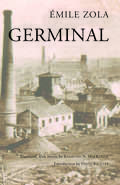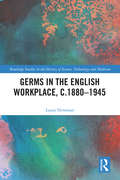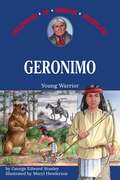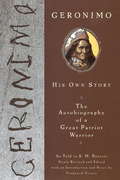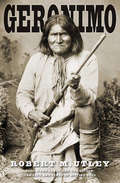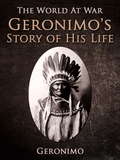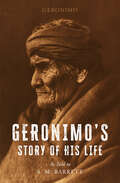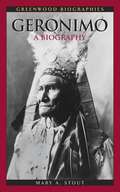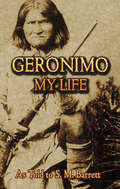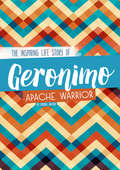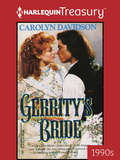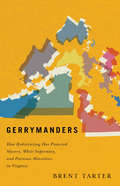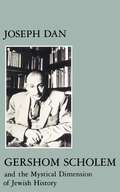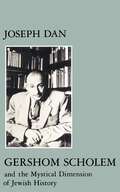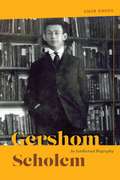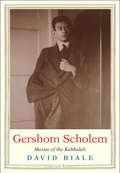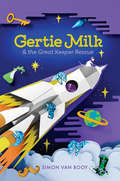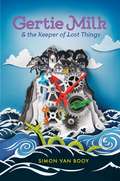- Table View
- List View
Germinal
by Emile Zola David Baguley Raymond N. MackenzieCoal mines have become rare, but the miners of Germinal are immortal. This new edition of the novel, with a translation by Raymond MacKenzie, is an exquisite tribute to their work, their misery and their eventual revolt. In his introduction, David Baguley--one of the most respected authorities on the work of Zola--brilliantly illuminates the genetic, historical and aesthetic aspects of the novel. His lucid, sensitive and critical gaze highlights the real secrets of the work: its underlying anthropological and social investigation, the dark power of the tragic imagination and the brightness of symbolic and mythic intuitions. --Henri Mitterand, Professor Emeritus, Columbia University
Germs
by Judith Miller Stephen Engelberg William J BroadIn the wake of the anthrax letters following the attacks on the World Trade Center, Americans have begun to grapple with two difficult truths: that there is no terrorist threat more horrifying -- and less understood -- than germ warfare, and that it would take very little to mount a devastating attack on American soil. In Germs, three veteran reporters draw on top sources inside and outside the U.S. government to lay bare Washington's secret strategies for combating this deadly threat. Featuring an inside look at how germ warfare has been waged throughout history and what form its future might take (and in whose hands), Germs reads like a gripping detective story told by fascinating key figures: American and Soviet medical specialists who once made germ weapons but now fight their spread, FBI agents who track Islamic radicals, the Iraqis who built Saddam Hussein's secret arsenal, spies who travel the world collecting lethal microbes, and scientists who see ominous developments on the horizon. With clear scientific explanations and harrowing insights, Germs is a masterfully written -- and timely -- work of investigative journalism.
Germs in the English Workplace, c.1880–1945 (Routledge Studies in the History of Science, Technology and Medicine #44)
by Laura NewmanThis book looks at how the workplace was transformed through a greater awareness of the roles that germs played in English working lives from c.1880 to 1945. Cutting across a diverse array of occupational settings – such as the domestic kitchen, the milking shed, the factory, and the Post Office – it offers new perspectives on the history of the germ sciences. It brings to light the ways in which germ scientists sought to transform English working lives through new types of technical and educational interventions that sought to both eradicate and instrumentalise germs. It then asks how we can measure and judge the success of such interventions by tracing how workers responded to the potential applications of the germ sciences through their participation in friendly societies, trade unions, colleges, and volunteer organisations. Throughout the book, close attention is paid to reconstructing vernacular traditions of working with invisible life in order to better understand both the successes and failures of the germ sciences to transform the working practices and material conditions of different workplaces. The result is a more diverse history of the peoples, politics, and practices that went into shaping the germ sciences in late nineteenth- and early twentieth-century England.
Germs: Biological Weapons and America's Secret War
by Judith Miller William Broad Stephen EngelbergAnalysis of the role of germs and biological weaponry in future wars.
Germs: Biological Weapons and America's Secret War
by Judith Miller Stephen Engelberg William J BroadIn the wake of the anthrax letters following the attacks on the World Trade Center, Americans have begun to grapple with two difficult truths: that there is no terrorist threat more horrifying -- and less understood -- than germ warfare, and that it would take very little to mount a devastating attack on American soil. In Germs, three veteran reporters draw on top sources inside and outside the U.S. government to lay bare Washington's secret strategies for combating this deadly threat. Featuring an inside look at how germ warfare has been waged throughout history and what form its future might take (and in whose hands), Germs reads like a gripping detective story told by fascinating key figures: American and Soviet medical specialists who once made germ weapons but now fight their spread, FBI agents who track Islamic radicals, the Iraqis who built Saddam Hussein's secret arsenal, spies who travel the world collecting lethal microbes, and scientists who see ominous developments on the horizon. With clear scientific explanations and harrowing insights, Germs is a masterfully written -- and timely -- work of investigative journalism.
Geronimo
by Bill DuganThe Apache Wars The blood of Geronimo's people is being brutally spilled by white invaders. Now, the proud Chiricahua Apache war chief prepares for the greatest and most desperate conflict of all--the final battle against the cruel might of the U.S. Army, which seeks nothing short of total extermination of the Apache. The government has dispatched the brilliant General George Crook, an army leader as strong and relentless as the Apache warrior himself. Locked together throughout the blistering Apache Wars, the cunning great chief and the complex white soldier will shape American history and seal forever the fate of the Apache nation. Impeccably researched, rich with real-life characters and period detail, this powerful historical novel vividly recounts the fury of the Apache Wars and their inimitable leader, Geronimo, from his first battle to his final, tragic betrayal and death. Leader of Power Geronimo knew how many white men wanted all Apaches--men, women, and children--dead. The White Eyes' newspapers were full of such talk. Orders had been given to exterminate them, sell the children into slavery in Mexico, whatever it took to assure that not one Apache still drew breath in Arizona or New Mexico. Geronimo would not have believed it, but one who knew English showed him the words in the newspaper. There was only one way to make sure that it didn't happen, and that was to strike first and to keep on striking until all the White Eyes were dead or had run for their lives. The mountains and deserts belonged to his people. The Mexicans hadn't been able to take them away, and the Americans were going to fall just as hard. If blood had to be spilled until there was no one left to bleed, that is how it would have to be. That was why he had decided to leave the reservation. Now that he was out, he intended to stay out, until he had won or until he could breathe no more.
Geronimo
by Meryl Henderson George E. StanleyIn this illustrated biography, young Apache Goyahkla and his friend play games in their village that will prepare him for his role as a hunter and warrior--and the place he will hold in history as Geronimo, fighter for the rights of his people.
Geronimo
by GeronimoEnter the world of Geronimo Stilton, where another funny adventure is always right around the corner. Each book is a fast-paced adventure with lively art and a unique format kids 7-10 will love. Ah, there's nothing like a relaxing vacation on the beach! I would spread out by the crystal-clear water with a good book. What more could a mouse want? At least, that was the plan. But somehow, my vacations never seem to go according to plan. Instead of a beautiful seaside resort, I found myself in a fleabag hotel that was falling down around my ears! Oh, would I ever be able to relax and enjoy my vacation??
Geronimo (The Lamar Series in Western History)
by Robert M. UtleyThis &“meticulous and finely researched&” biography tracks the Apache raider&’s life from infamous renegade to permanent prisoner of war (Publishers Weekly). Notorious for his ferocity in battle and uncanny ability to elude capture, the Apache fighter Geronimo became a legend in his own time and remains an iconic figure of the nineteenth century American West. In Geronimo, renowned historian Robert M. Utley digs beneath the myths and rumors to produce an authentic and thoroughly researched portrait of the man whose unique talents and human shortcomings swept him into the fierce storms of history. Utley draws on an array of newly available sources, including firsthand accounts and military reports, as well as his geographical expertise and deep knowledge of the conflicts between whites and Native Americans. This highly accurate and vivid narrative unfolds through the alternating perspectives of whites and Apaches, arriving at a more nuanced understanding of Geronimo&’s character and motivation than ever before. What was it like to be an Apache fighter-in-training? Why was Geronimo feared by whites and Apaches alike? Why did he finally surrender after remaining free for so long? The answers to these and many other questions fill the pages of this authoritative volume.
Geronimo's Story of His Life (The World At War)
by GeronimoGeronimo's Story of His Life is the oral life history of a legendary Apache warrior. Composed in 1905, while Geronimo was being held as a U.S. prisoner of war at Fort Sill, Oklahoma.
Geronimo's Story of His Life: As Told to S. M. Barrett
by Geronimo S. M. BarrettA pivotal piece of nineteenth-century Native American history from a tireless warrior seeking justice for his people. Storied leader of the Bedonkohe band of the Chiricahua Apache tribe, Geronimo led resistance against Mexican and American troops seeking to drive the Apache from their land during the 1850s through the 1880s. In 1886, he finally surrendered to the US Army and became a prisoner of war. Although he would never return to his homeland, Geronimo became an iconic figure in Native American society and even had the honor of riding with President Theodore Roosevelt in his 1905 inaugural parade. That same year, he agreed to share his story with Stephen M. Barrett, a superintendent of education from Lawton, Oklahoma. In Geronimo&’s own words, this is his fascinating life story. Beginning with an Apache creation myth, he discusses his youth and family, the bloody conflicts between Mexico and the United States, and his two decades of life as a prisoner. Revered by his people and feared by his enemies, Geronimo narrates his memoir with a compassionate and compelling voice that still resonates today.
Geronimo: A Biography
by Mary A. StoutApache warrior Geronimo led one of the last major independent Indian uprisings, and personified the struggle of Native Americans during westward expansion. Aimed at high school and undergraduate students, this biography provides an account of Geronimo's life from his traditional Apache upbringing to his final days as a celebrity prisoner of war, within the context of key historical and cultural events of his lifetime, including Native American traditions. The biography draws on primary sources such as Geronimo's autobiography and contemporary newspaper accounts, and is illustrated with b&w historical photos. A timeline and a glossary are also included. Stout is a librarian at Pima Community College in Tucson. She has published six books on Native American tribes. Annotation c2010 Book News, Inc., Portland, OR (booknews.com)
Geronimo: Leadership Strategies of an American Warrior
by Buddy Levy Mike LeachPlaying cowboys and Indians as a boy, legendary college football coach Mike Leach always chose to be the Indian--the underdog whose success turned on being a tough, resourceful, ingenious fighter. And the greatest Indian military leader of all was Geronimo, the Apache warrior whose name is so symbolic of courage that World War II paratroopers shouted it as they leaped from airplanes into battle. Told in the style of The 48 Laws of Power, Leach's compelling and inspiring book examines Geronimo's leadership approach and the timeless strategies, decisions, and personal qualities that made him a success. Raised in an unforgiving landscape, Geronimo and his band faced enemies better armed, better equipped, and more numerous than they were. But somehow they won victories against all odds, beguiling the United States and Mexican governments and earning the respect and awe of those generals committed to hunting him down. While some believed that Geronimo had supernatural powers, much of his genius can be ascribed to old-fashioned values such as relentless training and preparation, leveraging resources, finding ways to turn defeats into victories, and being faster and more nimble than his enemy. The tactics of Geronimo would be studied and copied by the U.S. military for generations. Drawing on his fascination and love for American Indian lore, Mike Leach explains how the tribe's organizational structure helped Geronimo be successful. He chronicles specific battles and shows how Geronimo got the most out of his warriors and outthought his enemies. Leach also captures the mysterious nature of leadership itself. Pain, pride, humility, family--many things shaped Geronimo's life. In this remarkable book, Mike Leach illustrates how we too can use the forces and circumstances of our own lives to build true leadership today.
Geronimo: My Life (Native American)
by Geronimo S. M. BarrettIn this, one of Native American history's most extraordinary documents, a legendary warrior and shaman recounts the beliefs and customs of his people. Completely and utterly authentic, its captivating narrator is the most famous member of the Apache tribe: Geronimo.The spiritual and intellectual leader of the American Indians who defended their land from both Mexico and the United States for many years, Geronimo surrendered in 1886. Two decades later, while under arrest, he told his story through a native interpreter to S. M. Barrett, an Oklahoma school superintendent. Barrett explains in his introduction, "I wrote to President Roosevelt that here was an old Indian who had been held a prisoner of war for twenty years and had never been given a chance to tell his side of the story, and asked that Geronimo be granted permission to tell for publication, in his own way, the story of his life."This remarkable testament is the result. It begins with Geronimo's retelling of an Apache creation myth and his descriptions of his youth and family. He explains his military tactics as well as traditional practices, including hunting and religious rituals, and reflects upon his hope for the survival of his people and their culture.
Geronimo: The Inspiring Life Story of an Apache Warrior (Inspiring Stories)
by Brenda HaugenGeronimo was one of the fiercest Apache warriors of all time. He was both admired and feared as he spent years fighting to preserve the Apache way of life in the American Southwest.
Geronimo: The True Story of America's Most Ferocious Warrior (Native American Ser.)
by Geronimo S. M. BarrettFirst published in 1906, Geronimo is the collaborative work between Geronimo, chief of the Chiricahua Apache, and author S. M. Barrett. The latter was given special permission from President Theodore Roosevelt to interview Geronimo while he was a prisoner of war at Fort Sill, Oklahoma. What Barrett recorded is a blunt, firsthand account of the twenty-five years Geronimo spent fighting the U.S. government. In Geronimo, the famous Native American discusses the history of the Apache people--where they came from, their early life, and their tribal customs and manners. Geronimo expresses his personal views on how the white men who settled in the West negatively affected his tribe, from wrongs done to his people and removal from their homeland to Geronimo's imprisonment and forced surrender. "I am thankful that the President of the United States has given me permission to tell my story. I hope that he and those in authority under him will read my story and judge whether my people have been rightly treated." --Geronimo This is the perfect book for anyone interested in the history of America and its native peoples, and this true-life account--from one of the most well-known figures in our country's history--is both thrilling and sobering.
Gerrity's Bride
by Carolyn DavidsonEmmaline Carruthers Shed More Than Her Clothes Under the Brutal Western Sun...Her "citified" ways went next, along with her plans for a quiet, dignified life. Instead, she found herself bound to a hotheaded cowboy in a most inconvenient marriage!Ranch foreman Matthew Gerrity was used to having things go his way. So why was he having so much trouble getting his Eastern beauty of a wife to accept that he was the one in charge?
Gerrymanders: How Redistricting Has Protected Slavery, White Supremacy, and Partisan Minorities in Virginia
by Brent TarterMany are aware that gerrymandering exists and suspect it plays a role in our elections, but its history goes far deeper, and its impacts are far greater, than most realize. In his latest book, Brent Tarter focuses on Virginia’s long history of gerrymandering to uncover its immense influence on the state’s politics and to provide perspective on how the practice impacts politics nationally.Offering the first in-depth historical study of gerrymanders in Virginia, Tarter exposes practices going back to nineteenth century and colonial times and explains how they protected land owners’ and slave owners’ interests. The consequences of redistricting and reapportionment in modern Virginia—in effect giving a partisan minority the upper hand in all public policy decisions—become much clearer in light of this history. Where the discussion of gerrymandering has typically emphasized political parties’ control of Congress, Tarter focuses on the state legislatures that determine congressional district lines and, in most states, even those of their own districts. On the eve of the 2021 session of the General Assembly, which will redraw district lines for Virginia’s state Senate and House of Delegates, as well as for the U.S. House of Representatives, Tarter’s book provides an eye-opening investigation of gerrymandering and its pervasive effect on our local, state, and national politics and government.
Gershom Scholem and the Mystical Dimension of Jewish History (Modern Jewish Masters #4)
by Joseph Dan"An excellent overview of the history of Jewish mysticism from its early beginnings to contemporary Hasidism...scholarly and complex."—Library Journal "An excellent work, clear and solidly documented by Joseph Dan on Gershom Scholem and on his work."—Notes Bibliographiques "An excellent guide to Scholem's work."—Christian Century
Gershom Scholem and the Mystical Dimension of Jewish History (Modern Jewish Masters)
by Joseph Dan"An excellent overview of the history of Jewish mysticism from its early beginnings to contemporary Hasidism...scholarly and complex."—Library Journal "An excellent work, clear and solidly documented by Joseph Dan on Gershom Scholem and on his work."—Notes Bibliographiques "An excellent guide to Scholem's work."—Christian Century
Gershom Scholem: An Intellectual Biography
by Amir EngelGershom Scholem (1897–1982) was ostensibly a scholar of Jewish mysticism, yet he occupies a powerful role in today’s intellectual imagination, having an influential contact with an extraordinary cast of thinkers, including Hans Jonas, Martin Buber, Walter Benjamin, Hannah Arendt, and Theodor Adorno. In this first biography of Scholem, Amir Engel shows how Scholem grew from a scholar of an esoteric discipline to a thinker wrestling with problems that reach to the very foundations of the modern human experience. As Engel shows, in his search for the truth of Jewish mysticism Scholem molded the vast literature of Jewish mystical lore into a rich assortment of stories that unveiled new truths about the modern condition. Positioning Scholem’s work and life within early twentieth-century Germany, Palestine, and later the state of Israel, Engel intertwines Scholem’s biography with his historiographical work, which stretches back to the Spanish expulsion of Jews in 1492, through the lives of Rabbi Isaac Luria and Sabbatai Zevi, and up to Hasidism and the dawn of the Zionist movement. Through parallel narratives, Engel touches on a wide array of important topics including immigration, exile, Zionism, World War One, and the creation of the state of Israel, ultimately telling the story of the realizations—and failures—of a dream for a modern Jewish existence.
Gershom Scholem: Master of the Kabbalah (Jewish Lives)
by David BialeA new biography of the seminal twentieth-century historian and thinker who pioneered the study of Jewish mysticism and profoundly influenced the Zionist movement Gershom Scholem (1897–1982) was perhaps the foremost Jewish intellectual of the twentieth century. Pioneering the study of Jewish mysticism as a legitimate academic discipline, he overturned the rationalist bias of his predecessors and revealed an extraordinary world of myth and messianism. In his youth, he rebelled against the assimilationist culture of his parents and embraced Zionism as the vehicle for the renewal of Judaism in a secular age. He moved to Palestine in 1923 and participated in the creation of the Hebrew University, where he was a towering figure for nearly seventy years. David Biale traces Scholem’s tumultuous life of political activism and cultural criticism, including his falling-out with Hannah Arendt over the Eichmann trial. Mining a rich trove of diaries, letters, and other writings, Biale shows that his subject’s inner life illuminates his most important writings. Scholem emerges as a passionately engaged man of his times—a period that encompassed two world wars, the rise of Nazism, and the Holocaust.
Gertie Milk and the Great Keeper Rescue (Gertie Milk #2)
by Simon Van BooyIn award-winning author Simon Van Booy's fantastical sequel to Gertie Milk and the Keeper of Lost Things, Gertie, Kolt, and Robot Rabbit Boy continue their adventures returning missing objects throughout history while trying to find out what happened to the imprisoned Keepers of Lost Things.Ever since Gertie Milk arrived on Skuldark, the mysterious island home of all lost objects, she's felt like something was missing. According to Kolt, her mentor and fellow Keeper of Lost Things, the island used to be filled with Keepers tasked with returning missing items throughout history. But now the only three left are Gertie, Kolt, and, Robot Rabbit Boy--a bumbling but lovable Series 7 Artificial Intelligence Forever Friend. So when Gertie learns that the missing Keepers have been imprisoned by the Losers, their unsavory adversaries, she decides to make it her mission to rescue the kidnapped Keepers and return them to Skuldark.But that proves more difficult than she'd imagined since her missions to return lost items don't seem to be taking them anywhere near the missing Keepers. Plus, it doesn't help that the Losers have an evil master plan much worse than their last one. This time, the entire future of the universe is at stake. Fueled by delicious cakes, jars of lemon curd, and plenty of Skuldarkian seawater, Gertie, Kolt, and Robot Rabbit Boy must travel through time (and outer space) to save their island home and rescue the Keepers--before the Losers manage to capture them all.
Gertie Milk and the Keeper of Lost Things (Gertie Milk #1)
by Simon Van BooyAward-winning author Simon Van Booy introduces readers to a magical, whimsical world, perfect for fans of Circus Mirandus and Serafina and the Black Cloak.When twelve-year-old Gertie Milk washes up on the island of Skuldark, she finds that all of her memories are gone. Home to helpful Slug Lamps, delicious moonberries, and a ferocious Guard Worm, the island is full of oddities, including a cozy cottage containing artifacts from every corner of history. It is there that Gertie discovers she has been chosen as the next Keeper of Lost Things, tasked with the mission of returning objects to history’s most important figures right when they need them most. With the help of a time machine disguised as a vintage sports car and the guidance of her fellow Keeper, Kolt, Gertie dodges an elephant army in ancient Alexandria, crashes a 1920s flapper party, and battles a ruthless Zhou Dynasty king. But soon, Gertie encounters an enemy that threatens everything the Keepers stand for: The Losers, villains who don't want to keep order but destroy it. Now, Gertie must uncover the truth of her own past if she wants to stop the Losers and set history back in place.
